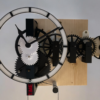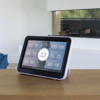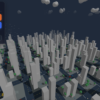Panoramas cover a complete 360 x 180 field of view and thus the image creation process has to take into account a range of lighting conditions which are at best averaged out over the entire scene. This process often results in a loss of detail in shadows or overblown exposures when photographing the sky or windows in the case of capturing an internal scene.
The quality of the image is further restricted by the cameras limited dynamic range when compared to the human eye – resulting in panoramas which often do not represent how the eye would naturally view a scene. To counter this we can use High Dynamic Range (HDR) imaging to capture a scene over a known number of exposure settings and thus create a series of images that reflect the dynamic range closer to that of human vision.
In our first test we have captured a view from the roof of University College London on a clear sunny day. This would normally result in dark shadows in sections of the image due to having to average the exposure over the whole panorama. A standard capture technique would result in the image displayed below:

If we then capture a further two versions of the scene – both under and over exposed respectively – we can capture a wider dynamic range:


Using HDR software these images can then be Tone Mapped to create a final view which includes both the shadows and the highlights of the scene:

A total of 21 images were captured to create the panorama compared to the normal 6 for traditional techniqes.
View the final HDR panorama (2.2mb).







